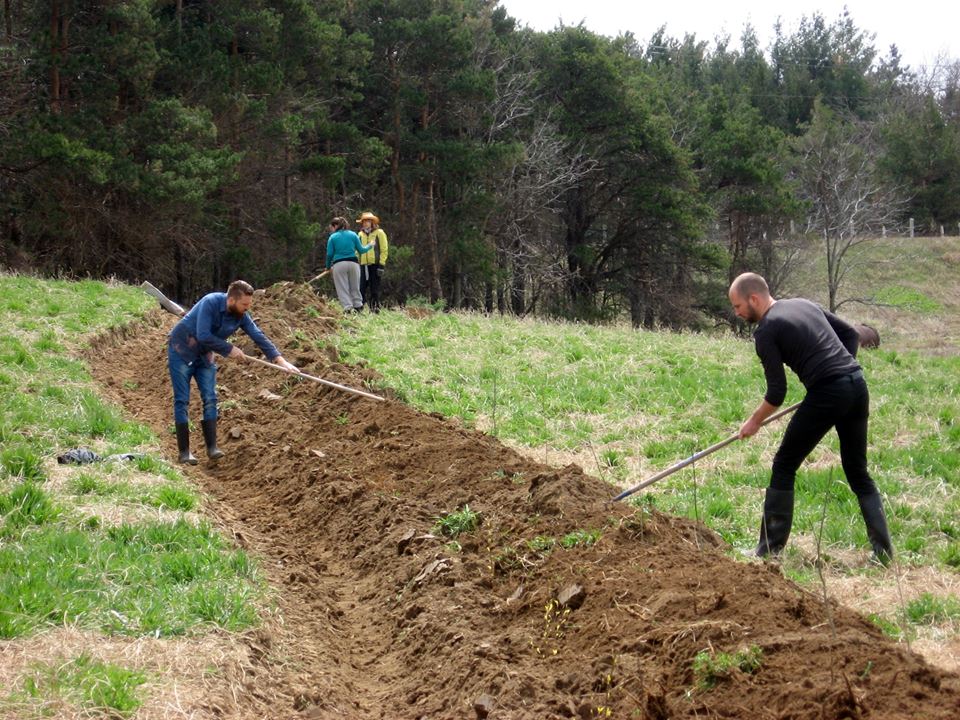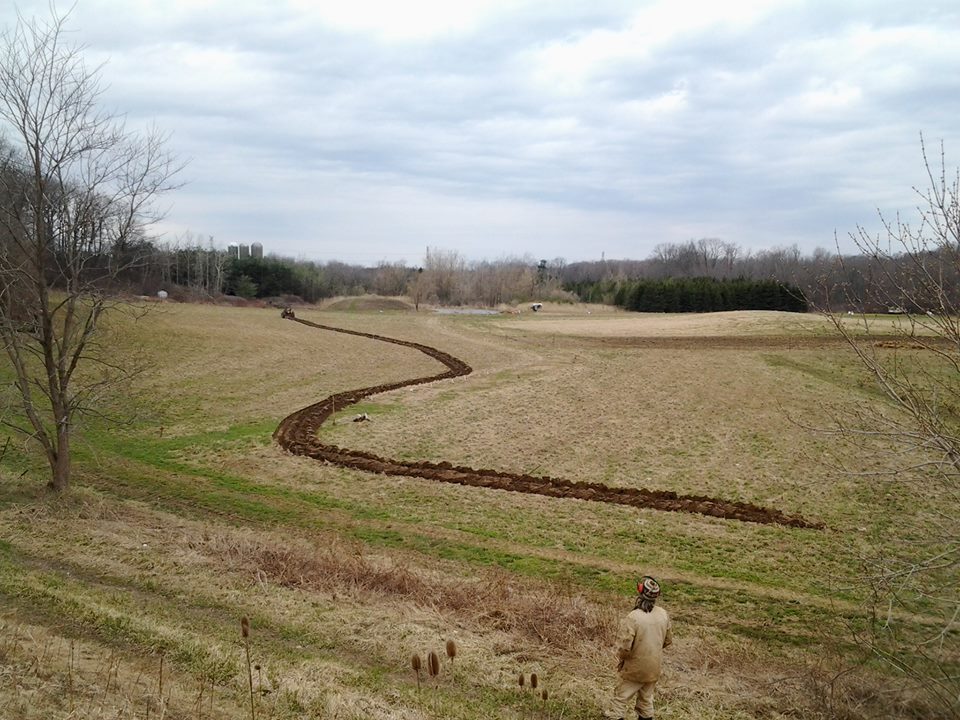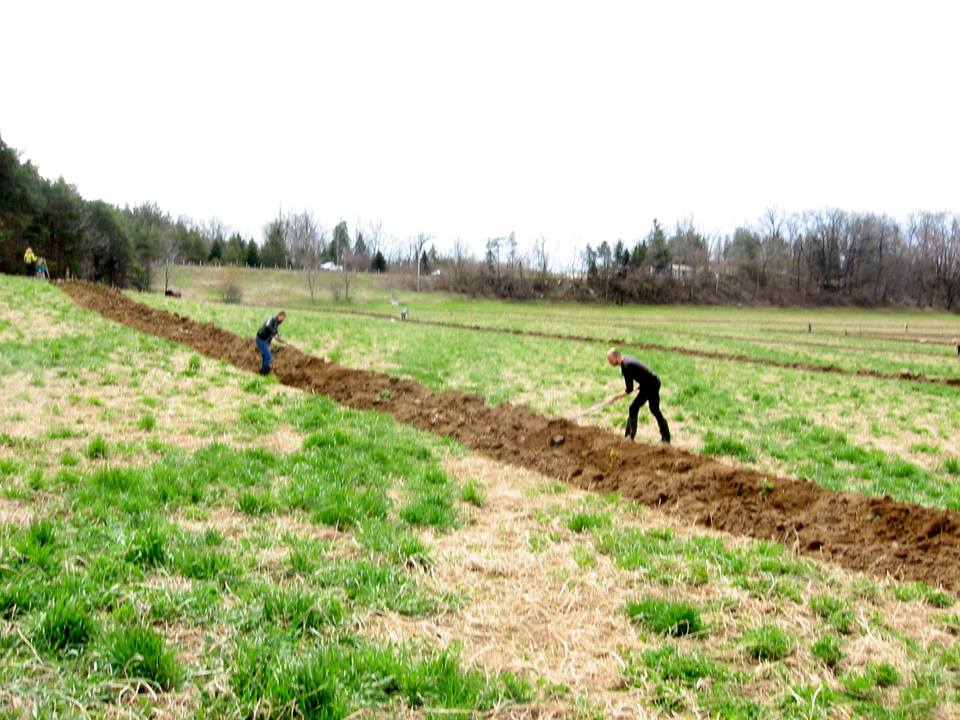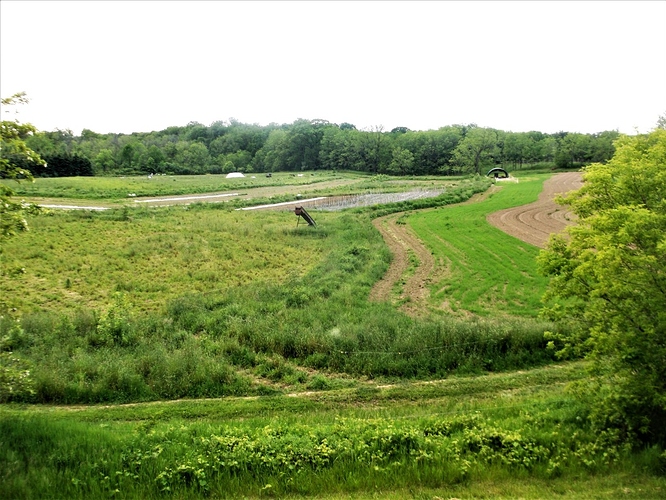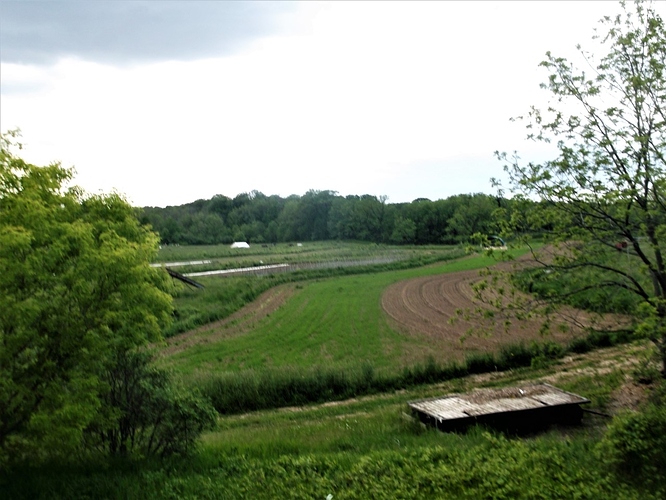We’ve been farming full-time “successfully” since 2011, using “conventional” small-scale, organic methods. We till the soil for our vegetables every year, plow, pass the s-tine, and use a fertilizer spreader for prep. We also do lots of green manure, which requires the tractor as well. Our garden is designed with our Kubota in mind and we waste lots of space and energy as a result.
We are concerned about the impact that our methods are having on the soil, and the environment in general (tar sands, pipelines, etc.) and have already noticed a hard pan has developed.
We have been inspired by Restoration Agriculture ala Mark Shepard and the Back to Eden film.
It makes us see permaculture as the way of the future, a better way to produce calories and feed the world, but we want to hear from you, our community, to see if anyone has attempted this sort of system commercially in Ontario, preferably north of Barrie.
Contrary to our leased land, our owned land is small (1.5 workable silt-loam tiled acres), so space is an issue. We are definitely considering doing berries, and some high-value annuals on a no-till permanent raised wood chip mulch bed. We’ve already established ourselves at our local farmers market (runs year-round) and would be glad to drop our CSA, which forces us to grow items that aren’t lucrative for us (ie potatoes) and is logistically heavy.
Does anyone have experience with this? Any advice would be amazing!
Don’t have much knowledge personally, but the one farm I know that operates this way and is close to Barrie is Foggy River Farm. Look them up!
Very beautiful looking place, thanks for mentioning them. I wonder how much they make on the workshops as opposed to the sale of their produce.
For the life of me, I haven’t been able to find a permaculture-based farm whose primary income comes from the sale of produce.
Do you know of any Denis (regardless of location in Ontario)?
Hi there! While I wouldn’t yet call Manorun a “Permaculture Farm” we did start the transition about 4 years ago to incorporate permaculture into our farm design. We had Mark Shepard out in 2012 for a consult that helped us reimagine our fields and how we grow vegetables in them. With his help we realized we could still use our tractor efficiently in these new systems. We put in swales, but kept them 100ft apart so we could fit 12 tractor passes(beds) between each swale. We rotate veg and livestock through these sections. The swale lines are filled with over 3,000 trees, shrubs, and native plants. These buffer zones conserve water, prevent wind and water erosion, will eventually feed people and animals, and are hot spots for biodiversity! We have a 150 CSA members and attend two markets, and this year have put in a farm store to sell meat as well. Our primary income is the vegetables.
If interested, you could come for a tour or chat with Chris Krucker about what we’ve done at the farm. We’re in Hamilton, so a bit of a ways from you.
Way to create a hybrid system! Some of what you are mentioning does in fact remind me of a few key points that Mark makes in his book, namely that creating beds in between tree rows allows you to keep gaining income/producing food while the permaculture aspects are allowed to sleep, creep then leap 
Do you anticipate being able to rely entirely on permaculture at some point? Some sort of retirement plan, perhaps?
Thanks for sharing your expertise and for the invite. We will certainly let you know if we are in the Hamilton area, which may happen, as Ryan has family in NOTL and Stratford (you are sort of in between the two!)
@naomi Would love to see some photos! 
@fieldgoodfarms I’m afraid I can’t think of any that earn the bulk of their income from produce… Sorry!
Hi, I’m new to the association and forum and just came across your post. I am a distributor of Tower Gardens. They are aeroponic vertical gardens - they use less resources and can be grown indoors. Maybe look at something like that as an option?
We just got one and are working on our seeds now but will be buying seedlings today to get things started. They are 2.5’ in diameter and stand about 5’2".
Let me know your thoughts. I’d be happy to share our photos and experiences with you.
Hi Donna,
Thanks for reaching out. I can see where you are coming from, but what I was truly seeking out is information on how to develop a permaculture-type system able to support the farm financially. The sources I’ve cited seem to hint that it is possible while caring for the ecosystem.
Furthermore, we are in transition to being organic certified, and as such, are not allowed to grow hydroponics. While wishing to avoid any further debate, I want to point out that I also agree in caring for, and growing in, the soil. There is something about all of the plastic and fertilizer mixes used in the process of hydroponics that I don’t feel align with my own personal ethics.
Having said this I wish you good luck in your current endeavour  I have no doubt that it will truly benefit certain folks wishing to take food production into their own hands directly at home. In an ideal world everyone who is physically able to would produce their own food.
I have no doubt that it will truly benefit certain folks wishing to take food production into their own hands directly at home. In an ideal world everyone who is physically able to would produce their own food.
I’d love to see examples of permaculture farms earning their living from sales of food, I agree that tourism, talks and books always seems to be their “bread winner” which seems odd to me. Then again, it does take time for the perennials to grow and start producing.
Most farms rely on several income streams, and despite feeling like many of the “permaculture” operations get a generous revenue stream from outreach I wonder how much of a boost it actually gives them? I know people often say our rental unit must be a huge help, but it just over 5% of our revenue stream, so a drop in the bucket.
Fruit orchards, I think, are the closest to permaculture operations on the ground making their living from food sales… despite not being necessarily organic or “permaculture”. That’s where I’d look for examples!
Absolutely my pleasure.
I wasn’t aware of the certification not allowing someone to grow hydroponics. Although this isn’t hydroponics, it is a form of, so I understand. The fruits and vegetables don’t grow in vermiculite - just water and ionic minerals.
Thanks for your well wishes, and I trust you’ll find what you’re looking for as well.
@donna.millingen Conventional hydroponics are not allowed under organic certification because typically the soluble nutrients required by the plants are of an inorganic nature (since organic nutrients are not so easily soluble). Anyone out there correct me if I am wrong.
Here are some photos. The first 3 photos are from four years ago when we dug the swale lines. They are on contour and about 100ft apart. We planted a whole mix of trees on the burm side of the swale and broadcast a native pollinator mix as the ground cover.
The last photos are now, and you can see that we grow vegetables, pasture animals, and have hay fields between the swale lines. Are veg beds are no longer straight! The trees in the swale lines are still small so the swales aren’t super noticeable yet.
I can’t believe you guys did all of that work by hand! I can definitely appreciate how much energy that took to create - and it is quite beautiful as a finished project. Thanks again for the photos!
I’m realizing now the pictures of people raking the swales are a bit deceiving… We actually used a 3 furrow plow (2 passes) to create the swales. Much cheaper than renting a back hoe, and MUCH less work than digging them by hand  The tree planting, mulching and maintenance was the most work intensive part of this system for sure. It’s certainly starting to pay off though.
The tree planting, mulching and maintenance was the most work intensive part of this system for sure. It’s certainly starting to pay off though.
Ya I noticed that on the second photo, but you still get full credit for all the hard work. 
Alleycropping seems like a probable stage for your farm at your farm scale so you can integrate perennial production seamlessly into your existing annual production without sacrificing much space or efficiency. This also applies to planting hedges/fedges and along unused perimeters of your limited acreage.
My farm in Meaford is probably a bit closer to you but be warned I am establishing it in reverse order: my perennial polyculture rows are now entering their 4th year of growth (I used silage tarp as a weed barrier); the rows are spaced 5m apart with alleycropping in mind but have yet to plant any significant annuals. I’m now finally getting around to advancing my house plans. Economically, I call them investments not expenses, and I have the long-term in mind. I’m pleased at how things are turning out so far but my results are still TBD.
Ivan
